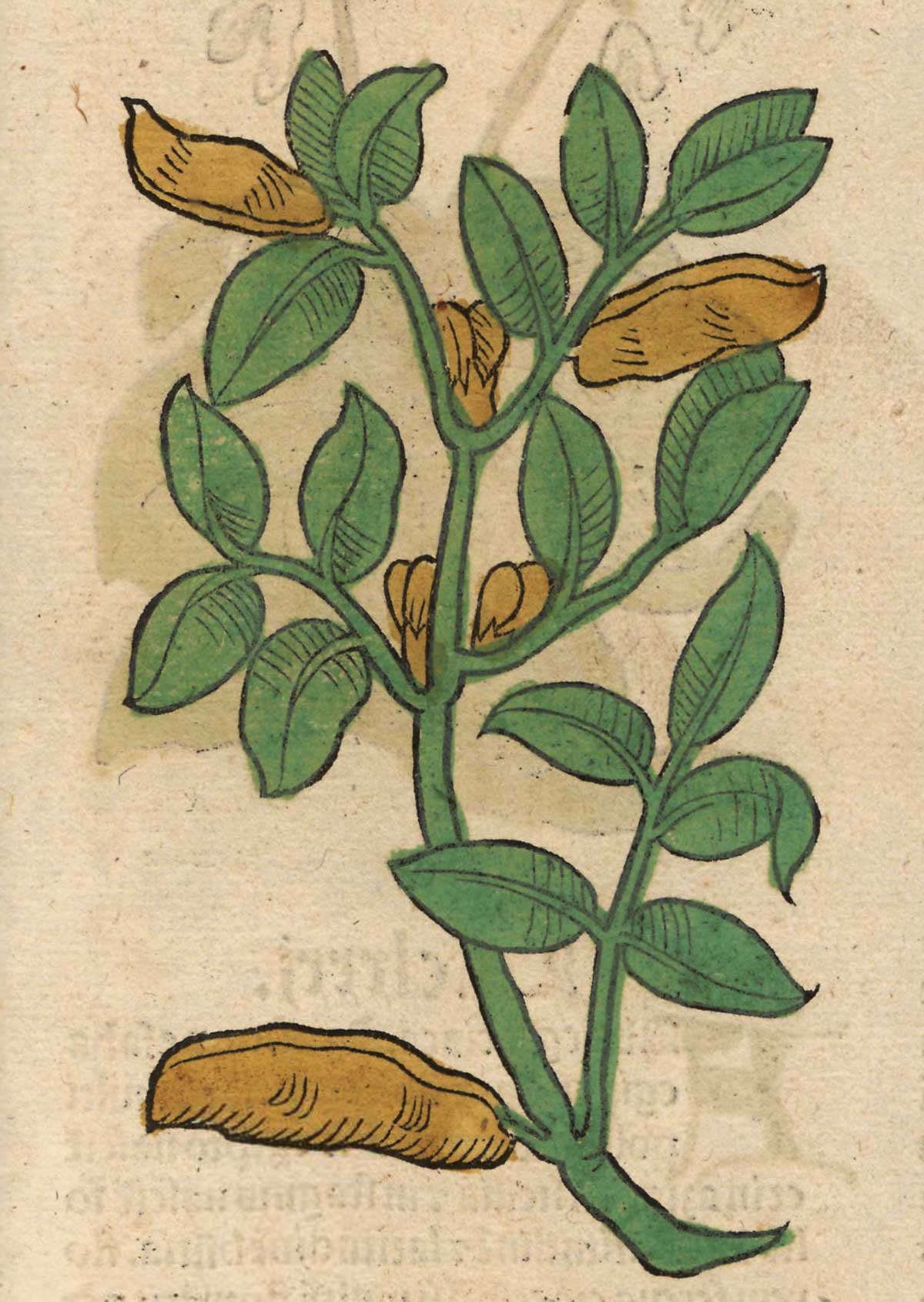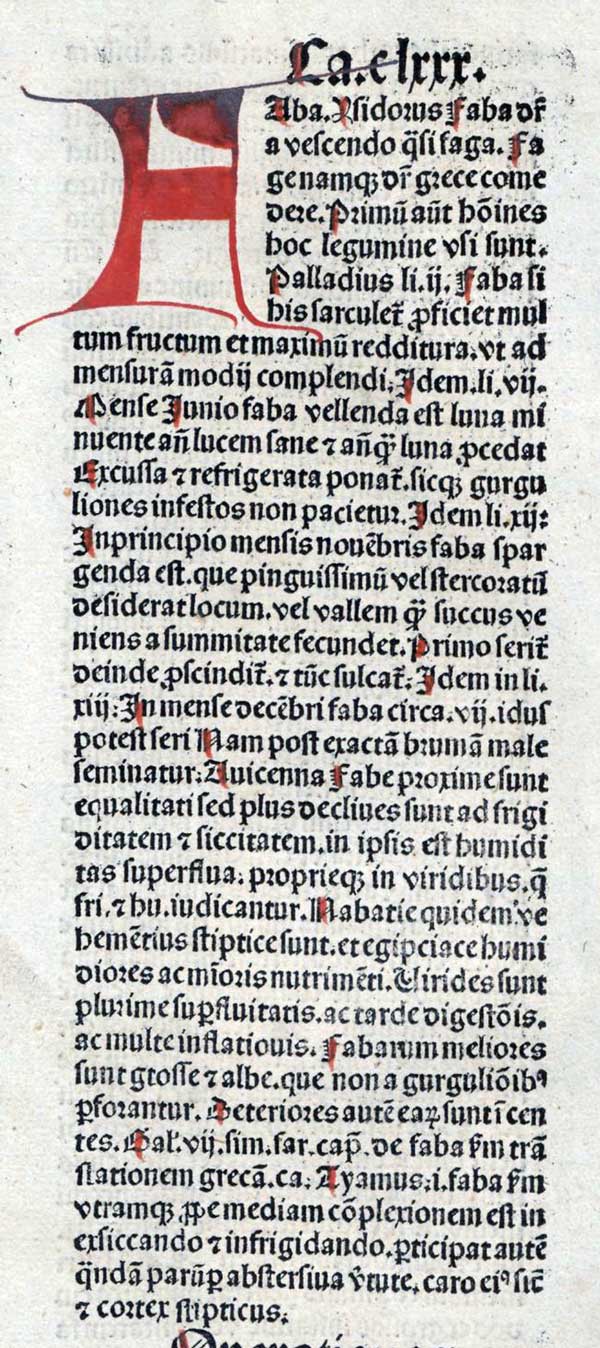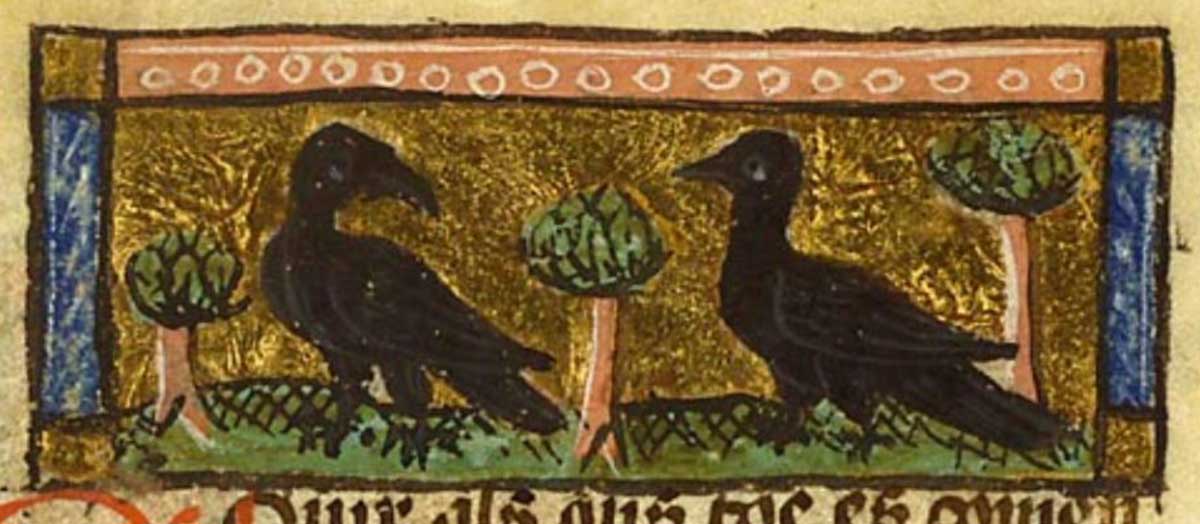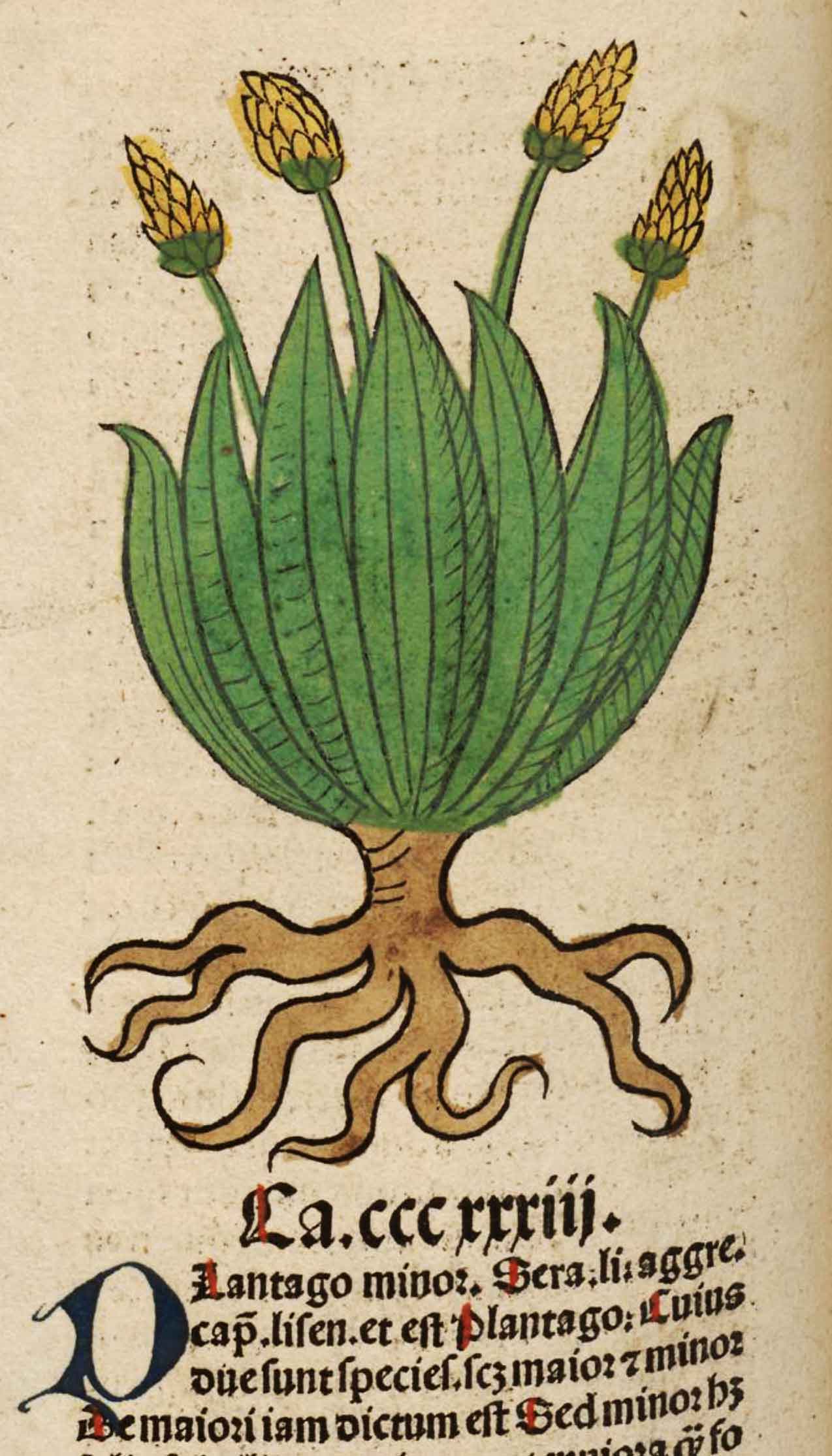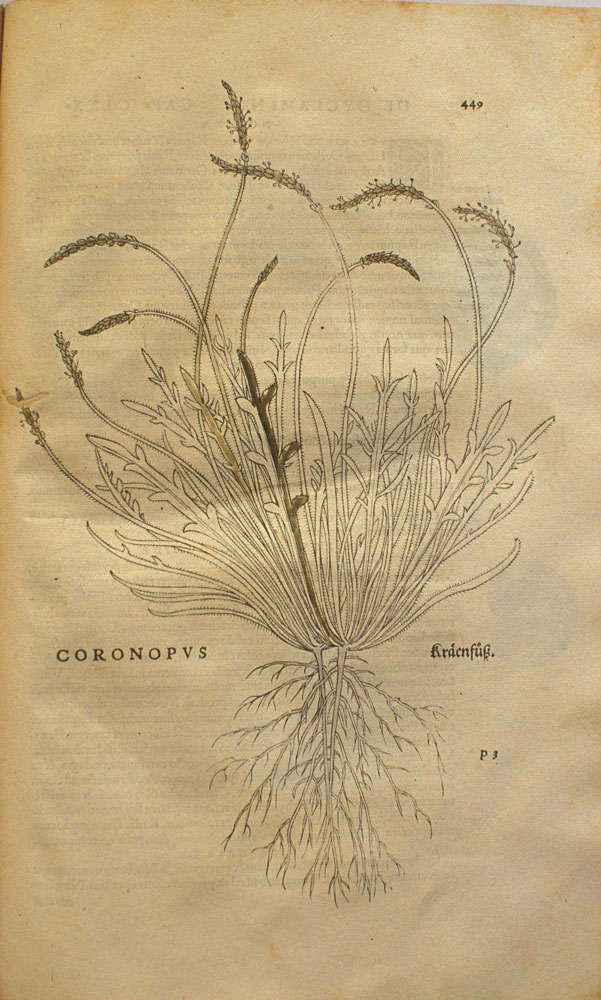Original French: Hippuris (c’eſt Prelle) car elle reſemble a queue de Cheual:
Modern French: Hippuris (c’est Prelle) car elle ressemble à queue de Cheval:
Notes
Equis (horse)

91.Equus (horse)
Fol. 18r
The Little Horse

Hippuris
Equisaetum hippuris Graecis dicta et in pratis vituperata nobis—est autem pilus terrae equinae saetae similis—lienes cursorum extinguit decocta fictili novo ad tertias quantum vas capiat et per triduum heminis pota. unctis esculentis ex ante diem unum interdicitur. Graecorum varia circa hanc opinio: alii pinus foliis similem nigricantem eodem nomine appellant, vim eius admirabilem tradentes, sanguinis profluvia vel tacto tantum ea homine sisti, alii hippurin, alii ephedron, alii anabasim vocant, traduntque iuxta arbores nasci et scandentem eas dependere comis iunceis multis nigris ut ex equorum cauda, geniculatis ramulis, folia habere pauca, tenuia, exigua, semen rotundum, simile coriandro, radice lignosa, nasci in arbustis maxime. vis eius spissare corpora. sucus sanguinem e naribus fluentem inclusus sistit, item alvum. medetur dysintericis in vino dulci potus cyathis tribus, urinam ciet, tussim, orthopnoeam sanat, item rupta et quae serpunt. intestinis et vesicae folia bibuntur, enterocelen cohibet. faciunt et aliam hippurim brevioribus et mollioribus comis candidioribusque, perquam utilem ischiadicis et vulneribus ex aceto inpositam propter sistendum sanguinem. et nymphaea trita plagis inponitur. peucedanum cum semine cupressi bibitur, si sanguis per os redditus est fluxitve ab infernis. sideritis tantam vim habet ut quamvis recenti gladiatoris vulneri inligata sanguinem claudat, quod facit et ferulae cinis vel carbo, fungus vero etiam efficacius, qui secundum radicem eius nascitur.
Equisaetum, called hippuris by the Greeks, and found fault with by me when I discussed meadow land [See XVIII § 259] —it is in fact “hair of the earth” resembling horse hair—reduces the spleen of runners if as much as the pot will hold is boiled down to one third in new earthenware, and taken in drink for three days in doses of one hemina. There must be abstinence from fatty foods for at least one day previously. The Greeks hold various views about this plant; some under the same name speak of a dark plant with leaves like those of the pine, assuring us that, so wonderful is its nature, its mere touch stanches a patient’s bleeding; some call it hippuris, others ephedron, others anabasis. Their account is that it grows near trees, which it climbs, and hangs down in many dark, rush-like hairs as if from a horse’s tail; that its little branches are jointed, and its leaves few, slender and small; that the seed is round, resembling that of coriander, that its root is ligneous, and that it grows mostly in plantations. Its property is to brace the body. Its juice, kept in the nostrils, checks haemorrhage therefrom, and it also checks looseness of the bowels. Taken in a sweet wine, in doses of three cyathi, it is good for dysentery, promotes passing of urine, and cures cough and orthopnoea, ruptures also and spreading sores. The leaves are taken in drink for complaints of the bowels and bladder; the plant itself reduces intestinal hernia. The Greeks recognise yet another hippuris, which has shorter, softer and paler hairs, making a very useful application in vinegar for sciatica, and also for cuts, as it stanches the flow of blood. Nymphaea also beaten up is applied to wounds from blows, and peucedanum with cypress seed is taken in drink if blood is brought up through the mouth or flows from the lower passages. Sideritis has such a powerful effect that if bandaged to a gladiator’s wound, however recent, it stops the bleeding, as does also the ash or cinders of fennel-giant, though more efficacious still is the fungus that grows about its root.
Pliny the Elder (23–79 AD),
The Natural History. Volume 7: Books 24–27. William Henry Samuel Jones (1876–1963), translator. Cambridge, Massachusetts: Harvard University Press, 1956. 26.83.
Loeb Classical Library
equisetum
herba optima in prato trifolii, proxima graminis, pessima nummuli siliquam etiam diram ferentis; invisa et equisaeti est, a similitudine equinae saetae.
The best crop in meadow land is trefoil, the next best grass; money-wort is the worst, and it also bears a terrible pod; horse-hair [The plant now called ‘horse-tail’], named from its resemblance to horses’ hair, is also a hateful weed.
Pliny the Elder (23–79 AD),
The Natural History. Volume 5: Books 17–19. Harris Rackham (1868–1944), translator. Cambridge, Massachusetts: Harvard University Press, 1950. 18.67.
Loeb Classical Library
hippuris
Du grecv ἲππουριζ, cristam ex setis equinis habens: de οὐρα, cauda, et ἲπποζ, equus.
Rabelais, François (1494?–1553),
Œuvres de Rabelais (Edition Variorum). Tome Cinquième. Charles Esmangart (1736–1793), editor. Paris: Chez Dalibon, 1823. p 270.
Google Books
Hippuris
Pliny xxvi. 13, §83.
Rabelais, François (1494?–1553),
The Five Books and Minor Writings. Volume 1: Books I-III. William Francis Smith (1842–1919), translator. London: Alexader P. Watt, 1893.
Internet Archive
Hippuris
Hippuris, de ϊπποζ, cheval, ὀνρά queue, allusion à la forme de la plante. — «Equisetum hippuris a Græcis dicta, … est autem pilus tertræ, equinæ setæ similis. » Pline, XXVI, 83. Ce nom, aujourd’hui transféré à une Hippuricacée (Hippuris vulgaris, L.), désignait alors la prêle ou Equisetum. Sainéan (L’histoire naturelle et les branches connexes dans l’œuvre de Rabelais, 122) y voit l’Elimosum, L. Pour Fée, l’hippuris ou ephedron de Pline est E. sylvaticum L. et l’hippuris altera E. arvense, L. (Paul Delaunay)
Rabelais, François (1494?–1553),
Oeuvres. Édition critique. Tome Cinquieme: Tiers Livre. Abel Lefranc (1863-1952), editor. Paris: Librairie Ancienne Honoré Champion, 1931. p. 354.
Internet Archive
hippuris
thus hippuris, meaning horsetail, because shavegrass looks like horses’ tails…
Rabelais, François (1494?–1553), Complete works of Rabelais. Jacques LeClercq (1891–1971), translator. New York: Modern Library, 1936.
pas similitude
Toutes ces plantes, dans De latinis nominibus, sauf pour le delphinium.
Rabelais, François (1494?–1553), Le Tiers Livre. Edition critique. Michael Andrew Screech (1926-2018), editor. Paris-Genève: Librarie Droz, 1964.
Hippuris
De ϊπποζ, «cheval», et οὐφά, «queue» (Pline, XXVI, lxxxiii).
Rabelais, François (1494?–1553), Œuvres complètes. Mireille Huchon, editor. Paris: Gallimard, 1994. p. 505, n. 1.
